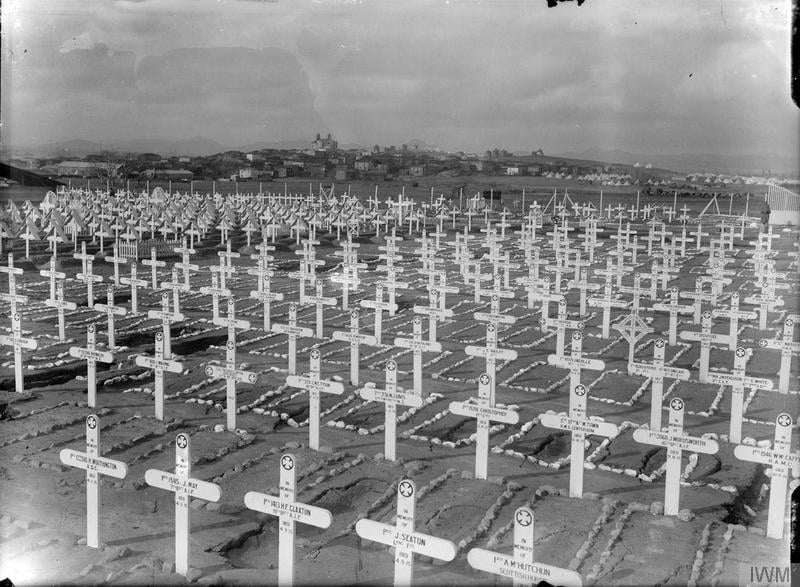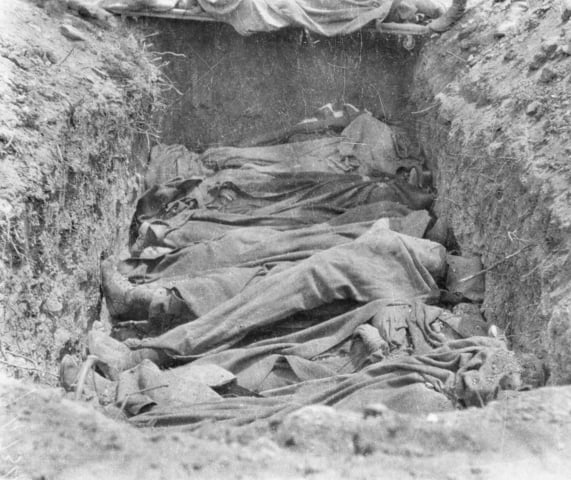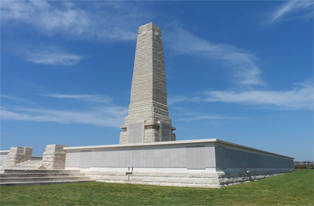


Apart from a one day truce on 24 May 1915, which allowed both sides at Gallipoli to bury their dead, there were no formal breaks in the fighting to collect and dispose of dead bodies. As a result many soldiers that had been killed in the fighting were abandoned, or else they were hastily disposed of in disused trenches and their bodies covered. Some cemeteries were built around the peninsula, and these would form the basis of the formal post-war cemeteries. Many soldiers, whether injured or sick, would die at sea while being transported away from Gallipoli, and these men were buried at sea after a brief service on board. Others, who made hospitals in Lemnos or Alexandria but then died, were buried in cemeteries there and their place of burial marked. However, on the peninsula itself the nature of the fighting and the high death toll meant that many men - 27,000 allied troops in total - have no known grave.
After the final evacuation of Gallipoli the allied forces had to leave whatever cemeteries had been constructed during the campaign, as well as all the informally buried bodies, behind them. At the end of the war the allies were able to return to Gallipoli and begin the process of locating and identifying the dead. In 1918 a Graves Registration Unit was sent to the peninsula to begin the task of locating all remains and, where possible, identifying them. It was incredibly difficult work. The peninsula was littered with impromptu burial sites, and the amount of live ammunition and artillery shells in the area made it dangerous. The job of the Graves Registration Unit was to track down all remains on the peninsula, attempt to identify them, formally rebury them and mark exactly where each set of remains had been buried. The men who worked for the Graves Registration Unit were volunteers drawn from the ranks of former soldiers, and they were paid a daily rate of 2s 6d per day. It was clearly harrowing work, and the men working for the unit were often absent from work, and known for their bouts of drunkenness. By the end of 1919 the smaller cemeteries from 1915 had been consolidated into larger ones, and bodies from across the peninsula had been brought to these cemeteries for reburial.

The Imperial War Graves Commission arrived in Gallipoli in late 1919 and were charged with the construction and maintenance of the formal cemeteries in the area. The plans for the various cemeteries on the peninsula were all drawn up by the Scottish architect Sir John James Burnet. All the commission cemeteries on the western front were designed with common architectural styles and features. That was not possible in Gallipoli due to the nature of the terrain, and the heavy damage done to the area by shelling and trench making. Also, the peninsula is open to the coast and a heavy prevailing wind that made the western front style of design unsuitable. To address these problems Burnet designed a series of cemeteries that would fit the landscape, while honouring the dead and housing those known and unknown remains. To achieve this there were three features specific to the Gallipoli cemeteries: 1) each cemetery would have a walled, rather than free standing cross, 2) each grave would be marked by low pedestal graves rather than headstones and 3) a rubble wall would encircle each cemetery to take away fast running storm water in the winter. The work was all completed (with the exception of the New Zealand memorial) by 1925. The work was supervised by commission staff who lived in Gallipoli for the duration of the build, and carried out by Turkish and Greek labourers. The necessary marble was mined locally. It also has to be remembered that the commission work at Gallipoli took place against the backdrop of the Turkish War of Independence and the creation of the Turkish state under Mustafa Ataturk.
In all there are 47 separate cemeteries where the allied and Turkish dead are buried on the peninsula, as well as a series of memorials dedicated to the missing. The largest memorial on the peninsula is the Helles Memorial. It serves as a memorial to all allied soldiers who served at Gallipoli, but is also a specific memorial to those soldiers - 20,885 of them - that have no known grave. These include all British, Irish and Indian soldiers, as well as those ANZACs who died at Helles. Each of their names are listed on panels on the memorial, and these include all those who were buried at sea. Irish men are buried and remembered at cemeteries and memorials across Gallipoli, but there is a high concentration of Irish at the main April landing point in V Beach Cemetery. The cemetery had been built initially in April 1915 straight after landings, but was later formalised by the War Graves Commission from 1919. In total the V Beach Cemetery memorialises 696 soldiers, of whom only 20 have known graves. Those remembered at V Beach Cemetery include Private Alfred Verrent of the 1st Battalion Dublin Fusiliers. Verrent, from Newport, Limerick, was only 17 when he died during the landings on 25 April, and was probably the youngest Irish man to die there.
The most significant commemoration happens annually on 25 April to mark the first day of the campaign. The event has been most closely linked with the ANZACs service and loss at Gallipoli, and there has been little formal Irish engagement with that day. In addition to the commemorations and visits held by Irish relatives and those connected with the various Irish battalions, the most significant official commemoration took place in March 2010. President McAleese visited Gallipoli, and visited V Beach as well as unveiling a memorial tablet to the 10th (Irish) Division. Aware of how the Irish memory of World War One was supressed in favour of those who fought in Dublin in 1916, McAleese noted, 'the cost to the Irish became a story lost, suppressed and neglected for many of the decades in between'.